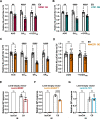This is a preprint.
Ribosomal quality control factors inhibit repeat-associated non-AUG translation from GC-rich repeats
- PMID: 37333274
- PMCID: PMC10274811
- DOI: 10.1101/2023.06.07.544135
Ribosomal quality control factors inhibit repeat-associated non-AUG translation from GC-rich repeats
Update in
-
Ribosomal quality control factors inhibit repeat-associated non-AUG translation from GC-rich repeats.Nucleic Acids Res. 2024 Jun 10;52(10):5928-5949. doi: 10.1093/nar/gkae137. Nucleic Acids Res. 2024. PMID: 38412259 Free PMC article.
Abstract
A GGGGCC (G4C2) hexanucleotide repeat expansion in C9ORF72 causes amyotrophic lateral sclerosis and frontotemporal dementia (C9ALS/FTD), while a CGG trinucleotide repeat expansion in FMR1 leads to the neurodegenerative disorder Fragile X-associated tremor/ataxia syndrome (FXTAS). These GC-rich repeats form RNA secondary structures that support repeat-associated non-AUG (RAN) translation of toxic proteins that contribute to disease pathogenesis. Here we assessed whether these same repeats might trigger stalling and interfere with translational elongation. We find that depletion of ribosome-associated quality control (RQC) factors NEMF, LTN1, and ANKZF1 markedly boost RAN translation product accumulation from both G4C2 and CGG repeats while overexpression of these factors reduces RAN production in both reporter cell lines and C9ALS/FTD patient iPSC-derived neurons. We also detected partially made products from both G4C2 and CGG repeats whose abundance increased with RQC factor depletion. Repeat RNA sequence, rather than amino acid content, is central to the impact of RQC factor depletion on RAN translation - suggesting a role for RNA secondary structure in these processes. Together, these findings suggest that ribosomal stalling and RQC pathway activation during RAN translation elongation inhibits the generation of toxic RAN products. We propose augmenting RQC activity as a therapeutic strategy in GC-rich repeat expansion disorders.
Conflict of interest statement
CONFLICT OF INTEREST The authors declare no competing interests.
Figures







References
-
- Koob M.D., Moseley M.L., Schut L.J., Benzow K.A., Bird T.D., Day J.W. and Ranum L.P.W. (1999) An untranslated CTG expansion causes a novel form of spinocerebellar ataxia (SCA8). Nat Genet, 21. - PubMed
-
- Lander E.S., Linton L.M., Birren B., Nusbaum C., Zody M.C., Baldwin J., Devon K., Dewar K., Doyle M., Fitzhugh W., et al. (2001) Erratum: Initial sequencing and analysis of the human genome: International Human Genome Sequencing Consortium (Nature (2001) 409 (860–921)). Nature, 412, 565–566. - PubMed
-
- Liquori C.L., Ricker K., Moseley M.L., Jacobsen J.F., Kress W., Naylor S.L., Day J.W. and Ranum L.P.W. (2001) Myotonic dystrophy type 2 caused by a CCTG expansion in intron I of ZNF9. Science (1979), 293. - PubMed
-
- Verkerk A.J.M.H., Pieretti M., Sutcliffe J.S., Fu Y.H., Kuhl D.P.A., Pizzuti A., Reiner O., Richards S., Victoria M.F., Zhang F., et al. (1991) Identification of a gene (FMR-1) containing a CGG repeat coincident with a breakpoint cluster region exhibiting length variation in fragile X syndrome. Cell, 65. - PubMed
Publication types
Grants and funding
- RF1 AG062171/AG/NIA NIH HHS/United States
- R01 NS086810/NS/NINDS NIH HHS/United States
- P50 HD104463/HD/NICHD NIH HHS/United States
- RF1 AG062077/AG/NIA NIH HHS/United States
- T32 GM007863/GM/NIGMS NIH HHS/United States
- I01 BX004842/BX/BLRD VA/United States
- P01 NS084974/NS/NINDS NIH HHS/United States
- P30 AG072931/AG/NIA NIH HHS/United States
- R01 NS099280/NS/NINDS NIH HHS/United States
- R01 NS113943/NS/NINDS NIH HHS/United States
- R35 NS097273/NS/NINDS NIH HHS/United States
- R01 NS097542/NS/NINDS NIH HHS/United States
- R56 NS128110/NS/NINDS NIH HHS/United States
LinkOut - more resources
Full Text Sources
Research Materials
Miscellaneous
